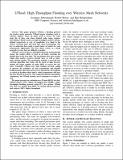| dc.contributor.author | Subramanian, Jayashree | |
| dc.contributor.author | Morris, Robert Tappan | |
| dc.contributor.author | Balakrishnan, Hari | |
| dc.date.accessioned | 2012-10-18T19:40:49Z | |
| dc.date.available | 2012-10-18T19:40:49Z | |
| dc.date.issued | 2012-05 | |
| dc.date.submitted | 2012-03 | |
| dc.identifier.isbn | 978-1-4673-0773-4 | |
| dc.identifier.issn | 0743-166X | |
| dc.identifier.uri | http://hdl.handle.net/1721.1/74109 | |
| dc.description.abstract | This paper proposes UFlood, a flooding protocol for wireless mesh networks. UFlood targets situations such as software updates where all nodes need to receive the same large file of data, and where limited radio range requires forwarding. UFlood's goals are high throughput and low airtime, defined respectively as rate of completion of a flood to the slowest receiving node and total time spent transmitting. The key to achieving these goals is good choice of sender for each transmission opportunity. The best choice evolves as a flood proceeds in ways that are difficult to predict. UFlood's core new idea is a distributed heuristic to dynamically choose the senders likely to lead to all nodes receiving the flooded data in the least time. The mechanism takes into account which data nearby receivers already have as well as internode channel quality. The mechanism includes a novel bit-rate selection algorithm that trades off the speed of high bit-rates against the larger number of nodes likely to receive low bitrates. Unusually, UFlood uses both random network coding to increase the usefulness of each transmission and detailed feedback about what data each receiver already has; the feedback is critical in deciding which node's coded transmission will have the most benefit to receivers. The required feedback is potentially voluminous, but UFlood includes novel techniques to reduce its cost. The paper presents an evaluation on a 25-node 802.11 test-bed. UFlood achieves 150% higher throughput than MORE, a high-throughput flooding protocol, using 65% less airtime. UFlood uses 54% less airtime than MNP, an existing efficient protocol, and achieves 300% higher throughput. | en_US |
| dc.description.sponsorship | National Science Foundation (U.S.) (Grant CNS-0721702) | en_US |
| dc.description.sponsorship | Foxconn (Sponsorship) | en_US |
| dc.language.iso | en_US | |
| dc.publisher | Institute of Electrical and Electronics Engineers (IEEE) | en_US |
| dc.relation.isversionof | http://dx.doi.org/10.1109/INFCOM.2012.6195831 | en_US |
| dc.rights | Creative Commons Attribution-Noncommercial-Share Alike 3.0 | en_US |
| dc.rights.uri | http://creativecommons.org/licenses/by-nc-sa/3.0/ | en_US |
| dc.source | MIT web domain | en_US |
| dc.title | UFlood: High-throughput flooding over wireless mesh networks | en_US |
| dc.type | Article | en_US |
| dc.identifier.citation | Subramanian, Jayashree, Robert Morris, and Hari Balakrishnan. “UFlood: High-throughput Flooding over Wireless Mesh Networks.” Proceedings IEEE INFOCOM, 2012. 82–90. | en_US |
| dc.contributor.department | Massachusetts Institute of Technology. Computer Science and Artificial Intelligence Laboratory | en_US |
| dc.contributor.department | Massachusetts Institute of Technology. Department of Electrical Engineering and Computer Science | en_US |
| dc.contributor.mitauthor | Subramanian, Jayashree | |
| dc.contributor.mitauthor | Morris, Robert Tappan | |
| dc.contributor.mitauthor | Balakrishnan, Hari | |
| dc.relation.journal | Proceedings IEEE INFOCOM, 2012 | en_US |
| dc.eprint.version | Author's final manuscript | en_US |
| dc.type.uri | http://purl.org/eprint/type/ConferencePaper | en_US |
| dspace.orderedauthors | Subramanian, Jayashree; Morris, Robert; Balakrishnan, Hari | en |
| dc.identifier.orcid | https://orcid.org/0000-0002-1455-9652 | |
| dc.identifier.orcid | https://orcid.org/0000-0003-2700-9286 | |
| dspace.mitauthor.error | true | |
| mit.license | OPEN_ACCESS_POLICY | en_US |
| mit.metadata.status | Complete | |
